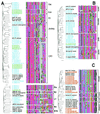Transposable elements in sexual and ancient asexual taxa
- PMID: 11121049
- PMCID: PMC18943
- DOI: 10.1073/pnas.97.26.14473
Transposable elements in sexual and ancient asexual taxa
Abstract
Sexual reproduction allows deleterious transposable elements to proliferate in populations, whereas the loss of sex, by preventing their spread, has been predicted eventually to result in a population free of such elements [Hickey, D. A. (1982) Genetics 101, 519-531]. We tested this expectation by screening representatives of a majority of animal phyla for LINE-like and gypsy-like reverse transcriptases and mariner/Tc1-like transposases. All species tested positive for reverse transcriptases except rotifers of the class Bdelloidea, the largest eukaryotic taxon in which males, hermaphrodites, and meiosis are unknown and for which ancient asexuality is supported by molecular genetic evidence. Mariner-like transposases are distributed sporadically among species and are present in bdelloid rotifers. The remarkable lack of LINE-like and gypsy-like retrotransposons in bdelloids and their ubiquitous presence in other taxa support the view that eukaryotic retrotransposons are sexually transmitted nuclear parasites and that bdelloid rotifers evolved asexually.
Figures



References
-
- Arkhipova I, Lyubomirskaya N, Ilyin Y. Drosophila Retrotransposons. Austin, TX: Landes; 1995.
-
- Capy P, Bazin C, Higuet D, Langin T. Dynamics and Evolution of Transposable Elements. Austin, TX: Landes; 1998.
-
- Robertson H M. J Hered. 1997;88:195–201. - PubMed
Publication types
MeSH terms
Substances
Associated data
- Actions
- Actions
- Actions
- Actions
- Actions
- Actions
- Actions
- Actions
- Actions
- Actions
- Actions
- Actions
- Actions
- Actions
- Actions
- Actions
- Actions
- Actions
- Actions
- Actions
- Actions
- Actions
- Actions
- Actions
- Actions
- Actions
- Actions
- Actions
- Actions
- Actions
LinkOut - more resources
Full Text Sources
Other Literature Sources
Molecular Biology Databases

